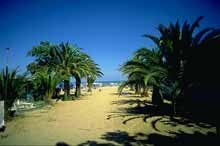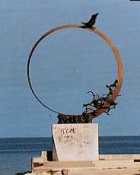
Since the second half of the nineteenth century, the Municipal Administrations tried to reclaim the whole area to the east of the railway and the first buildings lots on the so called "relitti del mare" ("sea relics") were accorded.
The first small detached villas were built on the sandy shore, at the same time as the Public Gardens, the Bathing Establishment and the Pine Copse were created.
Once the shock of the First World War was over, on l4th August 1921, the "Monument to the Fallen", a bronze work on a stone base by Mario Castaldi, that can still be admired today, was placed in a flower bed in the municipal gardens. Moreover at the same time, the idea of providing San Benedetto with a sea-front was being carried out. Engineer Onorati - a technician appointed first by the Tourist Board and then by the Local Council - did not devise the sea-front only as a new thoroughfare but also as an urban park. He must have been harshly criticized as his project was considered too ambitious, because none of the most famous holiday resorts of Italy seemed to have a similar panorarnic sea-front.
Despite this, work started in 1931 and in little over a year some decorum was finally conferred on what was considered a simple coast road southwards. Thus first stretch of the sea-front was built, thousands of exotic trees and plants were introduced (palms of many different species, such as phoenix canariensis, Pritchardia filifera, chamerops Humilis and chamerops excelsa, then ailanthus and pine trees, holm-oaks, etc..,) to frame and embellish balaustrades, semicircular areas and pavements (made with quartzite), the latter full of flower-beds. The centre of this sequence of works was the picturesque Rotunda, called Piazza Tommaso di Savoia (now C. Giorgini Rotonda), with a fountain that was to become the symbol of the entire sea-front.
All the citizens of San Benedetto, extremely enthusiastic, took part in the inauguration of the sea-front, at the end of July 1932, on the occasion of the memorable celebration of "Our Lady of the Sea". Since its completion, the sea-front of San Benedetto has been defined one of the most beautiful sea-fronts in Italy, if not the best.

When the Quarter of Porto D'Ascoli was annexed in 1935, they decided to et the sea-front to there, and at the end of the thirties the former GIL structure was built according to an integral rationalist plan. At the outbreak of the second world war people's expectations were put aside. Only afler the conflict had come to an end, and the bombardments had destroyed even part of the beautiful sea-front, when both social and economic life resumed, was a project made at last to create an avenue running all the way along the beach.
In the meantime, in winter 1946, the name of the first stretch of sea-front was changed into Viale Bruno Buozzi.
From the first months of 1948 once again the project was drawn up by Engineer Onorati, who decided to review his previous sketches and drawings several times, on the basis of what he had prepared before, in order to modify and above all enlarge avenues and pavements. In 1959 work began to complete both the road and the promenade by the sea.
From the sixties, the sea-front and adjacent area came to be for the people of San Benedetto and not only for them, an actual open-air fitness centre, while a camping site was opened there and hotels and accommodation facilities were built one after the other.